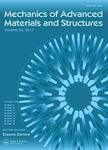版权所有:内蒙古大学图书馆 技术提供:维普资讯• 智图
内蒙古自治区呼和浩特市赛罕区大学西街235号 邮编: 010021

作者机构:South China Univ Technol Sch Civil Engn & Transportat State Key Lab Subtrop Bldg Sci Guangzhou 510640 Peoples R China
出 版 物:《MECHANICS OF ADVANCED MATERIALS AND STRUCTURES》 (先进材料力学与结构力学)
年 卷 期:2020年第27卷第21期
页 面:1789-1802页
核心收录:
学科分类:08[工学] 0805[工学-材料科学与工程(可授工学、理学学位)] 0801[工学-力学(可授工学、理学学位)]
基 金:National Natural Science Foundation of China [11972162, 11602087, 11932007, 11772134, 11772131, 11772132] China Scholarship Council Science and Technology Program of Guangzhou, China
主 题:Machine learning algorithm principal component analysis eigenvector time window damage localization damage quantification
摘 要:This paper aims to propose machine-learning-based damage identification methods with features derived from moving principal component analysis (MPCA) to improve the damage identification performance for engineering structures. Previously, machine learning algorithms have usually used structural responses as inputs directly. These methods show low damage identification capabilities and are susceptible to noise. In this paper, the eigenvectors of structural responses derived from MPCA are employed as inputs instead. Several traditional machine learning algorithms are applied for verification. The results demonstrate that as compared to strains and frequencies, their eigenvectors as inputs for machine learning algorithms render better performances for damage identification.